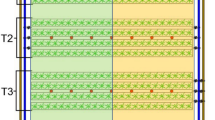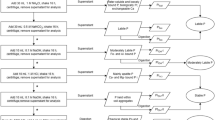Abstract
The large volume of wastewater generated on dairy farms from the cleaning of milk pipelines and milking equipment contains nutrients and microorganisms that could pollute waterways if discharged without treatment. The objective of this study was to evaluate a modified septic tank-seepage field system for disposing of milk house wastewater, by measuring the accumulation of nutrients in the soil and monitoring the water drained from the seepage field. The study was conducted on two small dairy farms (40–50 milking cows) in south-west Québec, Canada. After passing through a sediment and milk fat trap and then the septic tank, the milk house wastewater was drained into a 0.45 ha experimental seepage field under pasture or arable cropped land. Much larger than a conventional seepage bed (0.025 ha), the experimental seepage field was designed to remain recycle the wastewater nutrients and water, while preventing soil saturation. Annual nutrient loading from milk house wastewaters were, on average, 60 kg total N ha−1, 50 kg total P ha−1 and 80 kg total K ha−1. The concentrations of plant-available nutrients increased when milk house wastewater entered the seepage field, but the magnitude of change was farm-specific, due to the unique topography and soil characteristics offered by each farm. For instance, the P concentration was unchanged on one farm, but there was rapid and significant accumulation of P in the 20–60 cm depth of the soil profile on the second farm. There was an increase in Ca and Mg concentrations in the soil profile on both farms, but soil salinity remained <4 dS m−1 during this study. Water drained from the experimental seepage fields was similar in quality to that drained from a control area, indicating that the seepage fields were sufficiently large to adsorb and treat the nutrients contained in milk house wastewater in the short-term. Assessment of the cation and anion adsorption capacity of soils on these farms will be necessary to verify the treatment capacity and effective lifespan of the seepage fields.




Similar content being viewed by others
References
Alberta Agriculture. (2001). Salt tolerance of plants. Agri-facts, Agdex 518–17. Edmonton, AB, Canada: Alberta Agriculture, Food and Rural Development.
American Public Health Association (APHA). (1998). Standard methods for the analysis of water and wastewater (20th ed.). Washington, DC: APHA, AWWA and WPCF.
CRAAQ (Centre de Reférence en Agriculture et Agroalimentaire du Québec). (2003). Guide de référence en fertilisation (1st ed., p. 294). Sainte-Foy, QC, Canada.
Craggs, R. J., Tanner, C. C., Sukias, J. P. S., & Davis-Colley, R. J. (2003). Dairy farm wastewater treatment by an advance pond system. Water Science and Technology, 48, 291–297.
Havlin, J. L., Beaton, J. D., Tisdale, S. L., & Nelson, W. L. (1999). Soil fertility and fertilizers: An introduction to nutrient management (6th ed.). Upper Saddle River, NJ: Prentice Hall.
Health and Welfare Canada. (1996). Guidelines for Canadian drinking water quality (6th ed.). Ottawa, ON, Canada: Canada Communications.
Hendershot, W. H., Lalonde, H., & Duquette, M. (1993). Soil reaction and exchangeable acidity. In M. R. Carter (Ed.), Soil sampling and methods of analysis (pp. 141–145). Boca Raton, FL: Lewis.
Jamieson, R. C., Gordon, R. J., Cochrane, L. M., Madani, A., & Burney, J. R. (2002). Land application of milking centre wastewater. Canadian Biosystems Engineering, 44, 6.1–6.10.
Loerh, R. (1983). Pollution control for agriculture (2nd ed.). Orlando, FL: Academic Press.
Luostarinen, S. A., & Rintala, J. A. (2005). Anaerobic on-site treatment of black water and dairy parlour wastewater in UASB-septic tanks at low temperatures. Water Research, 39, 436–448.
Maynard, D. G., & Kalra, Y. P. (1993). Nitrate and exchangeable ammonium nitrogen. In M. R. Carter (Ed.), Soil sampling and methods of analysis (pp. 25–38). Boca Raton, FL: Lewis.
Ministère de l’Environnement du Québec. (1999). Regulation respecting the reduction of pollution from agricultural sources (amendment, April 7, 1999). Retrieved February 18, 2002, from http://www.menv.gouv.qc.ca/sol/agricole-en/amendments.htm.
Ministère de l’Environnement du Québec. (2000). Surface water. In D. R. Coote & L. J. Gregorich (Eds.), The health of our water: Towards sustainable agriculture in Canada (pp. 54–55). Ottawa, ON, Canada: Research Branch, Agriculture and Agri-Food Canada.
Morin, S., Lemay, S., Ali, A., & Barrington, S. (2004, August). A modified septic tank system to effectively manage agricultural wastewaters (Paper 229). Presented at the ASAE/CSAE Annual International Meeting, Ottawa, ON, Canada.
Murphy, J. H., & Riley, J. P. (1962). A modified single solution method for the determination of phosphorus in natural waters. Analytica Chimica Acta, 27, 31–36.
Newman, J. M., Clausen, J. C., & Neafsey, J. A. (2000). Seasonal performance of a wetland constructed to process dairy milk house wastewater in Connecticut. Ecological Engineering, 14, 181–198.
Reimann, W. (1997). Influence of organic matter from wastewater on the permeability of membranes. Desalination, 109, 51–55.
Rengasamy, P. (2006). World salinization with emphasis on Australia. Journal of Experimental Botany, 57, 1017–1023.
Schaafsman, J. A., Baldwin, A. H., & Steb, C. A. (2000). An evaluation of a constructed wetland to treat wastewater from a dairy farm in Maryland, USA. Ecological Engineering, 14, 199–206.
Steel, R. G. D., Torrie, J. H., & Dickey, D. A. (1997). Principles and procedures of statistics: A biometrical approach (3rd ed.). New York: McGraw Hill.
Tran, T. S., & Simard, R. R. (1993). Mehlich-extractable elements. In M. R. Carter (Ed.), Soil sampling and methods of analysis (pp. 43–49). Boca Raton, FL: Lewis.
Urgel Delisle et Ass. Inc. (1994). Évaluation de systèmes de fosse septique-champ d’épuration pour l’épuration des eaux usées de laiterie de ferme. Document produit pour le Ministère de l’Environnement du Québec sous le programme PARDE-PAAGF. Envirodoq EN 940584. Québec, Canada : Ministère de l’Environnement du Québec.
Wang, H., Magesan, G. N., & Bolan, N. S. (2004). An overview of the environmental effects of land application of farm effluents. New Zealand Journal of Agricultural Research, 47, 389–403.
Acknowledgments
The authors wish to recognize the financial contribution of the Conseil pour le développement de l’agriculture au Québec (CDAQ), le Club Bassin Rivière LaGuerre, and the Natural Science and Engineering Research Council of Canada. The team is also very thankful to Mr. Germain Lazure of Germain Lazure Inc. (St Urbain, Québec) for his useful design recommendations. We also thank an anonymous reviewer for helpful suggestions to improve an earlier draft of this manuscript.
Author information
Authors and Affiliations
Corresponding author
Rights and permissions
About this article
Cite this article
Morin, S., Whalen, J.K., Barrington, S. et al. Soil Nutrient Load and Drain Water Quality in Seepage Fields Receiving Milk House Wastewater. Water Air Soil Pollut 181, 51–63 (2007). https://doi.org/10.1007/s11270-006-9275-y
Received:
Accepted:
Published:
Issue Date:
DOI: https://doi.org/10.1007/s11270-006-9275-y




